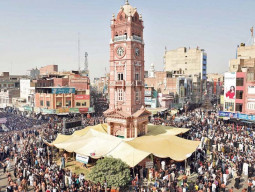1606123993-0/Daska-(9)1606123993-0.jpeg)
A mansion located in the ancient village of Ghartal near Daska is seen as a masterpiece of engineering by historians.
The area around the historic haveli named after the late Indira Gandhi, former prime minister of India, was inhabited by members of the Sikh and Hindu communities in Daska and its adjoining villages at the time of Partition.
In some villages, the number of Sikhs was higher, while in others the number of Hindus was higher. In villages where more Sikhs resided, Gurdwaras and mansions were more in number.
Hindu temples, houses and their culture were more prominent in their areas.
The narrow streets leading to the mansion used to be a famous locality, most notably for the exterior view of old houses.
The architecture of the haveli presents an enchanting view. A narrow turn towards the street leads to an open courtyard.
At the front, one witnesses a charming exterior of the mansion, a masterpiece of its time.
At one time, the interior of the mansion was adorned with ivory and exquisite woodwork.
However, in the present day, the dilapidated condition of the building speaks of a glorious past, power and dignity.
This building is a unique site for those interested in history and architecture.
A picturesque view of the old city could be observed from the mansion during the evening.
With every step in the narrow streets, the old but dilapidated houses signify the village’s beauty.
One such village is Ghartal, located 15km from Daska and adjoining the boundary of Sambrial tehsil. There were a large number of Hindus in Ghartal village.
In this age, the village is a prime place to observe the culture of the Hindu community.
When one reaches this village, it seems as he has reached the last century.
The locality still has about 30 houses built by Hindu residents in which the locals were living. The doors of the houses are made of wood from the same period. The balconies of the houses were also made of wood.
Reportedly, some of the houses have collapsed after being dilapidated.
The balconies of the old houses of the Hindu Diwan era are still intact. The people of the village settled here after Pakistan gained independence.
This village was known for this historic mansion.
This magnificent mansion of ancient architecture was built of limestone and small bricks and has exactly 100 doors.
Sharing a myth about the mansion, villagers told The Express Tribune that if these doors were counted, only 99 doors could be recorded and the 100th door was a mystery.
A surprising myth attributed to the mansion was that if one entered the residence by a ladder, she or he could not return from the same place. The person would eventually find other stairs. Moreover, all the doors of the mansion had iron locks and its walls were 13 inches to 28 inches thick.
Din Mohammad, the current owner of the 70-year-old mansion, said it was the haveli of Lala Ram Das Puri, built during a 20-year period by a contractor, Karam Din. “In this mansion there are still plaques on the walls of Lala Ram Das Puri. The doors and windows of the mansion are made of fragrant wood on which work of beautiful painting has been done.”
The mansion consists of three floors, he added. “A room at the top of the mansion was a place of worship for Hindus. There was a tunnel under the mansion. The path of this tunnel connects to a pond outside the village.”
There are two parts of the pool, one for men and the other for women, he further said. “Now the pond is in a very dilapidated condition and there is dirty water standing there. Precious stone used in building the pond has also disappeared.”
The village of Ghartal was inhabited by people of the Diwan caste who ruled the region.
Published in The Express Tribune, November 23rd, 2020.

1606124273-0/Daska-(1)1606124273-0.jpeg)
1606124231-0/Daska-(2)1606124231-0.jpeg)
1606124202-0/Daska-(3)1606124202-0.jpeg)
1606124171-0/Daska-(4)1606124171-0.jpeg)
1606124144-0/Daska-(5)1606124144-0.jpeg)
1606124090-0/Daska-(6)1606124090-0.jpeg)
1606123937-0/Daska-(8)1606123937-0.jpeg)


1737758094-0/Trump-(11)1737758094-0-165x106.webp)









1737703688-0/AItools-(14)1737703688-0-270x192.webp)

1737614355-0/Express-Tribune-(1)1737614355-0-270x192.webp)








COMMENTS
Comments are moderated and generally will be posted if they are on-topic and not abusive.
For more information, please see our Comments FAQ